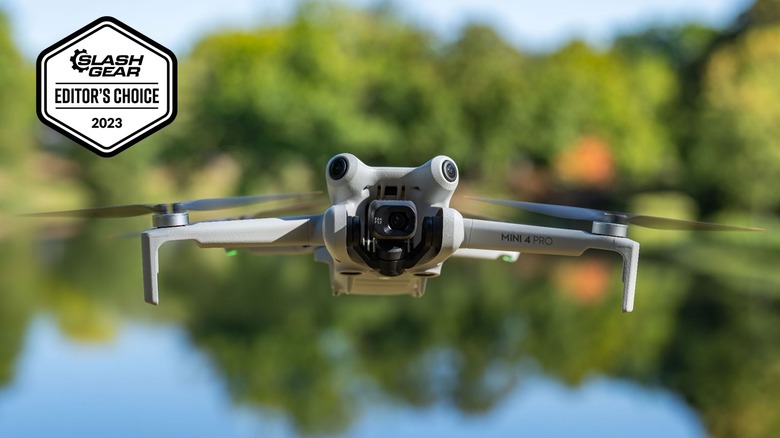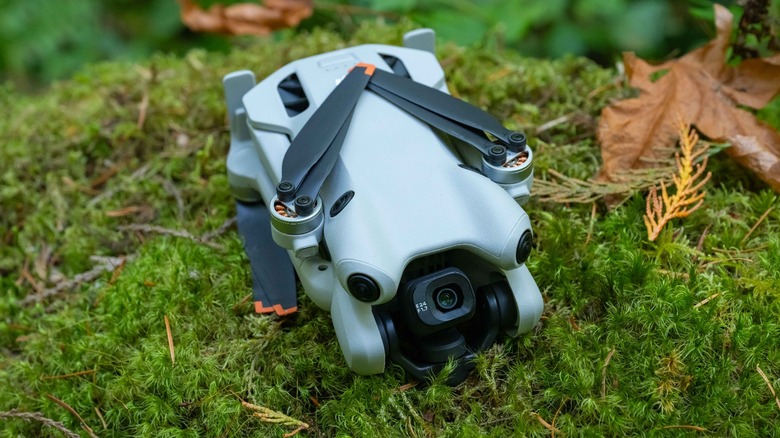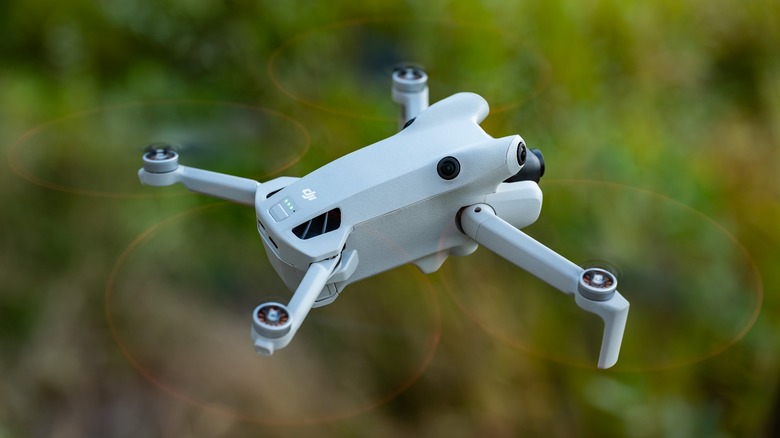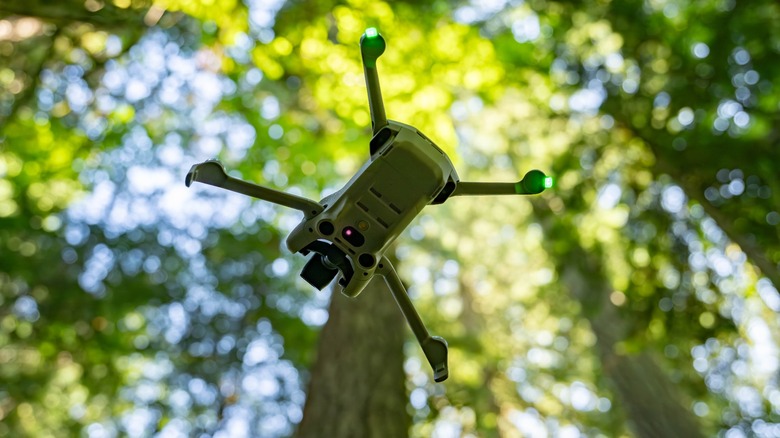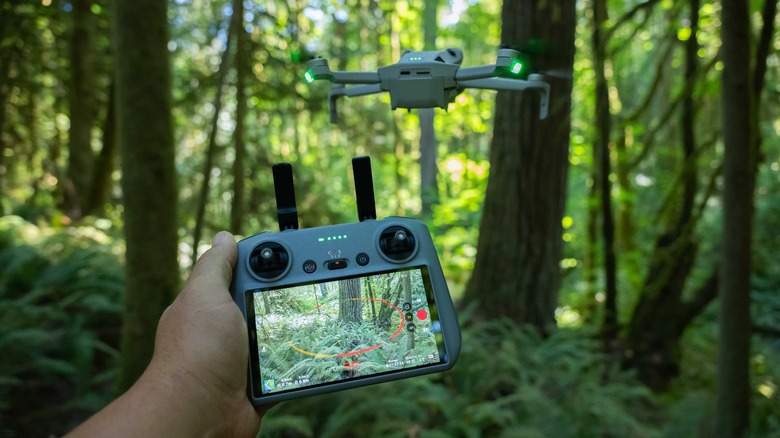DJI Mini 4 Pro Review: Flagship Features In A Pocket Sized Drone
- 249 gram weight makes it easier to fly with fewer restrictions
- Extremely portable
- Excellent image quality
- Long battery life
- Omnidirectional obstacle sensing
- 360 degree object tracking
- True vertical shooting
- 4k 100fps slow motion video
- Extremely robust transmission system
- Only an evolutionary upgrade from the Mini 3
Normally the only advantage to tech being small and lightweight is portability — when it comes to drones every gram matters for ease of use. Few drones can claim to be smaller and lighter than the new DJI Mini 4 Pro and still deliver such an impressive resume of capabilities. The Mini 4 Pro appears, at least on paper, to be a minor upgrade from previous Mini series drones, yet that's no bad thing, given how relevant the previous Mini 3 Pro remains. These tiny drones are built to deliver most of what a big drone can do — but without the same regulatory hurdles. Also, a small drone that weighs basically nothing is far more likely to find a place in your luggage than a larger, bulkier device.
The questions to be answered are whether the Mini 4 Pro is a meaningful upgrade over its predecessor, and if it remains compelling in the presence of DJI's expansive and highly capable drone lineup.
DJI provided SlashGear with a sample of the Mini 4 Pro to test and review.
The 249 gram sweet spot
From a practical, physical perspective, the Mini 4 Pro is a particularly portable little drone. It's small enough to fit in a large pocket, and its incredible lightness of weight is immediately noticeable in the hand. This means the Mini 4 Pro is far more likely to find a place in your luggage for a trip to distant shores, or in a backpack to be carried up a mountain. Even in the specially made carrying case which may be bundled with the Mini 4 Pro — with the controller and a couple of extra batteries thrown in — the whole footprint is no more than that of a typical compact camera.
Great as the Mini 4 Pro may be from a portability perspective, the light weight of this drone has a very clear purpose. It's precisely designed to weigh in at only 249 grams, and as such it falls within less stringent regulations in many nations. This makes it much easier to fly, removing barriers of entry to new pilots and opening the door to easier international travel with your drone in tow.
The drone is physically very similar to the Mini 3 Pro, with the now standard folding arms and forward-mounted camera gimbal. The battery slides and clips in at the back below the exposed USB-C port and Micro SD card slot. Having the port and slot exposed rather than hidden behind a concealing door makes the Mini 4 Pro somewhat more vulnerable to rain.
Great camera, with an exciting twist
The Mini 4 Pro includes the same wide-angle camera as the one found in the more expensive DJI Air 3, though you of course aren't getting the extra telephoto camera found in that drone. This 1/1.3-inch 48mp sensor paired with a 24mm f1.7 lens delivers beautiful aerial imagery without the compromises typically expected in a tiny and inexpensive drone.
In terms of video specs, the Mini 4 Pro can shoot in 4k at 60fps with D-LogM, and the camera is now capable of HDR video, as well as a new night mode. The footage looks as good as we have come to expect from this sensor and lens and delivers results that surpass the expectations of such a diminutive form factor. It can also shoot 4k at up to 100fps or 1080p at up to 200fps in a dedicated slow-motion mode. In practice, this delivered good results, but we would have also liked to see perhaps a 2.7k 120fps option to deliver slow motion video at relatively high resolution with a final output of 30fps, whereas the existing slow motion formats are designed with 25fps output in mind.
The party trick of the Mini 4 Pro, as with previous Mini series drones, is the ability of the camera to flip on its side and deliver native vertical video using the full sensor. This makes it perhaps the best drone out there for creating short-form vertical format content for social media.
Waypoints, upgraded subject tracking, and obstacle avoidance
The Mini 4 Pro is much smarter than its predecessors, and now includes many of the convenient intelligent features of other current-generation DJI drones. The inclusion of a waypoint mode will be particularly attractive to many pilots, as it allows for pre-planned routes and cinematic movements, which can later be revisited for interesting transitional effects such as a summer scene turning to winter, or day to night.
Thanks to 360-degree subject tracking, the Mini 4 Pro is much better at following subjects, and at avoiding catastrophe. It's very good at seeing potential obstacles around it, though not so much above it. We trimmed a few branches while moving upwards – but fortunately, the drone is quite robust despite its low weight and delicate appearance. It came through all mishaps without a single scratch.
In the horizontal plane and when descending, it was practically flawless in terms of obstacle detection in our testing. This is best evidenced by the occasion where the automatic return to home function triggered when we were flying in a dense old-growth forest. The Mini 4 Pro flew up a hundred feet above the forest floor and then proceeded to carefully thread itself through the canopy to its takeoff point.
Nimble with a robust signal
While the low weight and diminutive size of the Mini 4 Pro might lead you to believe that it might not handle as well as a beefier drone, we found that it has plenty of zip and handles as well as we've come to expect from modern drones. Furthermore, with Occusync 4.0 transmission, the Mini 4 Pro offers a really solid and reliable connection with crisp visuals. This is really important, as better visibility and a robust signal improve safety and boost pilot confidence.
Battery life is excellent, though with a maximum flight time of 34 minutes, it's a few minutes shy of the DJI Mini 3. However, in practice, 34 minutes is a long time, and your average flight time in the real world is certain to be less than that. You can also opt for larger, plus-size batteries which increase the maximum battery life to 45 minutes. These plus-sized batteries are what we used, and with them, we never felt restricted by the battery life of the Mini 4 Pro. However, keep in mind that the larger batteries tip the scale and put the Mini 4 Pro over that 249-gram sweet spot.
Also of note is the impressive GPS reception of the Mini 4 Pro. We found that we could get a strong signal even at the bottom of a valley in a deep forest within a few minutes of booting up the drone.
Great accessories and a few irritating elements
The Mini 4 Pro brings to the table an option for quite literally expanding your horizons. DJI now offers a super-wide angle lens for the drone which clips onto the camera in the same way as a filter and provides a 100-degree field of view. The look is very much comparable to an action camera and can be used to create a dramatic FPV drone-style look, or simply to capture more expansive scenes in a single image.
Another optional accessory is an ND filter set, which has become standard to launch alongside new DJI drones. As with the wide-angle lens, these clip onto the front of the camera, and they do so quite securely. Also, swapping them is remarkably quick and easy, though they are quite small so it's somewhat of a delicate process. Interestingly, they are particularly strong, starting at ND16, then jumping to ND64, and then all the way to ND256. That last one is startlingly dim, yet impressively, all three filters render colors quite nicely and don't degrade sharpness noticeably.
The fly in the ointment has to do with the standard included accessories. The cap for the gimbal and camera is of the typical hard plastic variety, which is never great to use, and far worse is the plastic ring which is meant to clasp around the Mini 4 Pro during transport. It's extremely difficult to attach, has a fragile clasp, and most people will never use it.
A little more expensive, but still a great value
The Mini 4 Pro flies in at a base price of $759 with the DJI RC-N2 Remote Controller, which is the same cost as the Mini 3 Pro. This tiny little drone offers the bulk of what is available in much more expensive models such as the Air 3 and is even not too far off in many ways from the Mavic 3 Classic. This makes it perhaps the best bang for your buck drone on the market, though serious drone photographers will still want to take advantage of the seriously impressive camera array featured in the Mavic 3 Pro.
Of course, you're likely to spend a bit more than the base price for an upgraded bundle. We highly recommend at least getting the $959 bundle, which includes the DJI RC 2 controller with a built-in screen. The $1,099 fly more combo is certainly worth picking up, as with any drone you're almost certain to eventually want the extra two batteries and charging hub. There's also the top-end DJI Mini 4 Pro Fly More Combo Plus bundle we tested, which swaps out the standard batteries for the higher capacity versions, though as previously noted this puts you over the advantageous 249-gram limit.
Conclusion
For those in the market for their first drone, who own an older drone, or who feel their larger drone is hindering them for physical or regulatory reasons, then the DJI Mini 4 Pro is an easy choice to recommend. However, If you already own the DJI Mini 3 or Mini 3 Pro, there's not a lot of reason for you to upgrade to the Mini 4 Pro.
This is a fairly modest, evolutionary upgrade over the previous generation, and that's OK. The higher available frame rates are very welcome, as are the newly included intelligent features and capture capabilities, and for novice pilots, the omnidirectional obstacle sensing could really be a drone-saving feature. Perhaps my favorite upgrade, however, is the inclusion of Occusync 4.0 transmission, as a strong, stable connection to the drone is paramount to me to ensure the safe operation of the device. A lot of people will also find the inclusion of waypoint capability very exciting.
So, while the Mini 4 Pro isn't a huge step forward from the drones that came before it, this is nonetheless an important refinement. While the Mavic 3 and Air 3 are superior in their capabilities, the Mini 4 Pro is the drone I'd recommend to most people. It's just a really good drone that can do everything the vast majority of pilots will ever need, and its size, weight, and price point make it far more approachable than other options.
